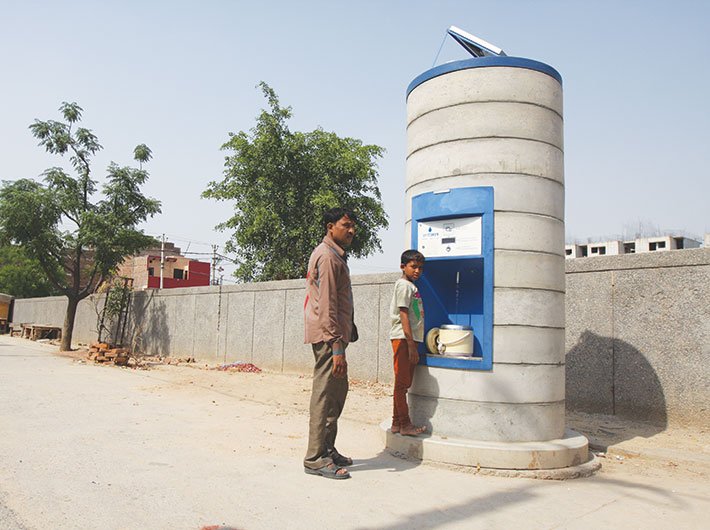Sarvajal project in a Delhi colony has led to a bigger debate: should water supply be privatised?
A nondescript colony in north-west Delhi is quietly experimenting with privatised water supply while the jury is still out on privatisation of essential services.
Savda Ghevra, which started off as a resettlement colony to take the ugliness of jhuggi-jhopri (JJ) clusters out of Delhi in pre-Commonwealth Games days, has successfully done so – literally, by relocating the ugliness. Resettled in a slipshod, typical government way, settlers were allotted small plots of land and hustled here in 2006. Basic amenities, however, gave the place a complete miss. So, there are people living here, but there are no electric poles, sewage system, or proper drinking water supply.
The residents had to go to the nearby Ghevra village to fetch water. But the local Jat community there was not friendly and water frequently led to squabbles between villagers and their new neighbours. Slowly, Delhi Jal Board (DJB) tankers started coming to the area, providing some relief to the residents. But the water supplied by the tankers was neither sufficient to meet the daily requirements of Savda Ghevra residents, nor was it always of potable quality. Add to that the tension building up in the serpentine queues for a bucket or two of water and the frequent spats over the scarce resource. So, people started installing submersible pumps to draw groundwater. But groundwater was too saline to drink.
Not left with many alternatives, the residents somehow managed with DJB tanker water.
Enter Sarvajal
In 2012, DJB began considering a proposal to supply drinking water through a pay-and-use water ATM scheme. In February 2012, it floated a tender to decentralise drinking water in urban areas. Sarvajal, which had had some prior experience in providing clean drinking water, won the tender. Due to the trifurcation of the Delhi municipal corporation a year ago and because of multiple agencies handling the tender, permission for land and borewell, it took almost 18 months for the '40-lakh project to take off.
It took another three months for construction and installation. Sarvajal, a brand of Piramal Water Private Limited, supplies drinking water across cities, towns and villages in Rajasthan, Gujarat, Uttar Pradesh, Madhya Pradesh, Haryana, Delhi and Maharashtra. It started operating water ATMs in Savda Ghevra from January 2014. DJB spread the word in the area through awareness drives in local schools. Soon people started getting their prepaid smartcards made.
User’s perspective
On a hot and muggy early July morning, Ravi Kumar made his way through the narrow lanes of Savda Ghevra till the main road. Armed with two big plastic containers, the 26-year-old stopped in front of a concrete cylindrical structure and set his containers down. He then reached into his pocket and took out a plastic card. The moment he touched it to a slot in the structure, he got a reading and, with a final push of a button, the concrete structure started dispensing water. Kumar, who drives a battery-operated rickshaw, had installed a submersible pump at his home but said the groundwater it pumped out was saline. His family of five requires 10 litres of water daily, which is now met by a recharge of '100 for his card that lasts him 15 days.
Kumar spent '100 as initial charge for the Sarvajal smartcard. At the rate of 30 paise per litre, Kumar, who took the Sarvajal connection about six months ago, finds it cheap. He explained: “If a family member falls ill after consuming contaminated water, I will end up spending much more in hospital visits.” Kumar would know, as his wife was down with severe diarrhea two years ago.
Is privatisation the only way?
Sarvajal is safe as far as its water is concerned but there is the bigger issue of privatisation of essential services.
Detractors feel once water becomes a commodity, it changes from being a social resource to a commercial or tradable resource. Under such circumstances, water systems start transforming into market operations. This means those who cannot afford to pay for it will be thrown out or pushed to the periphery of the system. Given the number of poor people in India, commoditisation of water could have serious consequences.
Shripad Dharmadhikary, an activist and researcher who works on water-related issues and is associated with Manthan Adhyayan Kendra, said, “Water for basic services, including cooking and other domestic needs, for cattle and livelihood, and food security, is part of the social obligation of the state and should be ensured to everyone regardless of their ability to pay.”
Himanshu Thakkar, coordinator of South Asia Network on Dams, Rivers and People (SANDRP), agrees with Dharmadhikary. “Since the state has failed at its responsibility, it has invited business through PPP (public-private partnership). This, however, does not mean there is less water. Water is available in local sources,” he said.
Thakkar is of the opinion that Sarvajal can be used temporarily while DJB works out the infrastructure bottleneck. “The permanent solution to the water woes,” he said, “would be to lay down water pipelines in the area”.
In a country with wide disparities of income and wealth, privatisation is largely considered a nuisance. Privatisation of water is viewed as a ruse by international agencies – World Bank, World Trade Organisation (WTO) and donor agencies such as Department for International Development (DFID), which believe in free market ideology – to create markets for its companies.
“Over the last decade or so, some of this has been internalised by the central and state governments and now they are taking initiatives on their own,” said Dharmadhikary. “There is a fundamental contradiction between the basic character of private enterprise that is driven by profit motive, and the social obligations of the state, as far as water is concerned,”
he added.
Also, now in India, there are big corporate interests who would benefit from privatisation – both in terms of contracts for running such ATMs and also helping them get easier and reserved access to water. Experience has shown that privatisation has not worked in any part of the world, particularly in the context of basic needs. Even in the US and many countries of Europe, water supply is still largely public; where privatisation has been initiated, it has faced resistance. There is also a move to give such privately run operations back to the civic bodies.
The whole process of privatisation has been focussed on the financial aspects of water management. This single-point focus has led to neglect of many other key issues – environment, protection and conservation of water resources, access and equity to water, among others. Further, when water becomes a marketable commodity, the main concern is centred on maximising economic returns or profits; naturally, disregarding or externalising environment issues helps increase these.
Dharmadhikary also said privatisation would not necessarily generate adequate employment or provide access to more clean drinking water.
The other side
Reacting to the debate against water privatisation, Anuj Sharma, chief operating officer at Sarvajal, said though he favours providing free drinking water to people, purification and transportation costs had to be met. “Anything which is free gets wasted. The water supplied by the municipal corporations is of drinkable quality (but) people use the same water for flushing, mopping and cleaning. The idea is to determine how to utilise a limited resource,” he said.
Rubbishing concerns that the groundwater level is going down due to overdrawing, Sharma said despite submersibles and the Sarvajal filtration plant there will still be plenty of groundwater left. “DJB harvests rain water in the area to sustain the project. Besides, it is a recently developed area and groundwater is easily available. DJB tests water quality once every month. Since people are using it only for domestic purposes it will not be a pressure on the resources,” he added.
Blaming the politicians, jal board spokesperson Sanjam Cheema told Governance Now: “The DJB can plan for the infrastructure but the decision to release water will be a political one. Pipelines can be laid only if there is enough water to be sent through them.”
Challenges persist
At Savda Ghevra, meanwhile, despite an apparent relief challenges remain. Ram Vir, who draws Sarvajal water regularly, complained of low water pressure at the water ATM: “It takes 15 minutes to fill one container. It leads to a big queue in front of the ATMs.”
Recharging the smartcard is another problem that many face. Usually the residents give money to the tanker operator when he comes to fill the ATMs and he gets them recharged. But if they miss the tanker, it becomes very difficult to get the card recharged, they said. In that case they have to go as far as Nangloi to get the cards recharged.
The colony has 15 Sarvajal ATMs that cater to the 13 blocks. Amit Mishra, general manager, operation and maintenance at the Sarvajal filtration plant in Savda Ghevra, said, “Operationally, the project has been successful, although acceptance among people has been low. Out of 8,500 households in the colony, only 1,000 are using water ATMs.
“The Sarvajal cards are being used by only 10-15 percent of the colony. We have tried to make them understand the benefits of drinking filtered water, but many still prefer to get their water from DJB tankers,” he added. ATMs in the vicinity of the plant charge 15 paise per litre and for other areas the cost is 30 paise per litre. Mishra explained that the difference in rate is due to transportation costs.
The project has had its own share of challenges. “Attempts have been made to vandalise the ATMs. Five such incidents have taken place in the past one year. To minimise such incidents, we have started engaging people, telling them that the service is for their own benefit,” Mishra said. But he said there has never been any breakdown in the network so far.
Though the Delhi government plans to replicate the Sarvajal model in 10 more slums and resettlement colonies, Sarvajal has not made any profit from the project so far. Sharma, though, said he hoped to recover the costs over the next few years. “But if we can’t convince the community, it might never happen,” he added. Sarvajal will increase the number of ATMs only if demand rises.
Residents of this remote colony finally have a solution to acute water shortage. The sustainability of the project, however, is still in the works.
The story appeared in the August 1-15, 2014 issue of the magazine.

